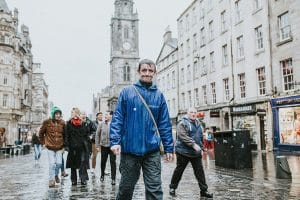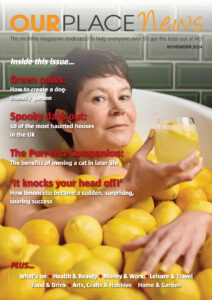Vicky Spratt walks a Royal Mile in another person’s brogues on an enlightening tour of the Scottish capital.

In 1998 Angus Stirling became homeless for the first time. It was a stint on the streets that lasted several years. In 2009, a relationship breakdown left him sleeping rough again.
The 65-year-old is from Aberdeen but now living in Edinburgh where he has spent years wandering the city and living on its streets, studying its old buildings.
Now, he is putting his knowledge to good use, working as a tour guide for Invisible Cities. It is a social enterprise which trains people affected by homelessness to become walking guides in their own city.
There are many walking tours in Edinburgh as it’s the best way to see the city’s nooks and crannies: ghost tours, black history tours
and mystery, murder and legend tours. “This isn’t going to be a Harry Potter tour of the city,” Angus says firmly, making it clear that there will be no speculation about the location of Hogwarts.
The tour given by the former builder focuses on his passions: architecture and history. Edinburgh is a city built of sandstone and, like it was for Scottish novelist Robert Louis Stevenson, it is “a dream in masonry and living rock,” to Angus.
“I am really interested in building materials and techniques,” he tells me as we weave through the Old Town’s closes. “Old stones are my passion.” Angus waxes lyrical about his favourite buildings and laments what he calls the “dodgy” decisions of town planners.
“I like the old rugged stone walls,” he huffs “but under the Victorians everything was made a bit more manicured because they wanted it to look less Scottish and more English.”
He points to evidence of this along the Royal Mile where some of the older buildings (such as the preserved 17th-century tenement
house Gladstone’s Land) have a rougher stone façade than others which have been covered with smooth sandstone. “The Victorians did that because they wanted it to look grander and less Scottish,” Angus quips.
We are in the medieval part of Edinburgh which has been designated a World Heritage Site. Its street pattern is often described as resembling the skeleton of a fish: the Royal Mile is the spine and the closes – steep, narrow, pedestrianised alleyways – span out from it.
At the end of the alleyways, you’ll find more historic tenements which are hidden from view. Angus leads me to them excitedly, pointing to low-covered doorways and his favourite: gingery orange hued walls.
“People think of Edinburgh as all grand grey stone,” he says, “but there was a tradition of using something known as Copperas render which is basically iron sulphate to create this ochre-coloured wash.
You don’t see as much of it around these days as you should. It wasn’t just used to inject colour but to add a layer of weather protection to rough stonework. “Nothing is worse than a badly built structure,” Angus jokes. As we move through the city, he points out the buildings he considers to be badly built or restored and shares his love of Mary Queen of Scots.
He then explains that health problems brought his career as a builder to an end. After that, he worked as a gravedigger and a kitchen porter before eventually ending up on the streets.
Invisible Cities has been a lifeline for Angus. He found out about it from staff at the Big Issue a few years ago and, through working for them as a guide, has managed to move his life in a different direction.
As his tour comes to an end at St Giles Cathedral – one of Scotland’s most important medieval parish church buildings – I ask Angus what’s next for him. “I’m trying to move back to Aberdeen which is where my family are,” he explains. He plans to continue working for Invisible Cities as a guide after the move. “I think Aberdeen is much plainer than Edinburgh. It might not be as grand but it’s got incredible architecture too.”
The founder of Invisible Cities, Zakia Moulaoui, meets me after my tour with Angus at the Kimpton Charlotte Square Hotel. Historically, Scotland has been the most forward-thinking part of the UK when it comes to tackling homelessness. It remains the first part of Britain to adopt a formal, Government-backed “housing first” strategy.
The premise is simple: you house homeless people immediately, regardless of their needs. It is a philosophy that influenced Zakia when she set up Invisible Cities. She works closely with other organisations that provide housing, food and other support services. More than that, she has partnered with local businesses, including the Kimpton.
“The Kimpton is a five-star hotel,” she explains. “The staff kindly agreed to train our guides in customer service which means they get to gain new skills which help them get back into the world of work.” It’s the sort of 360 approach that makes so much sense you wonder why it isn’t rolled out nationally.
Travel essentials
Getting there: Train service Lumo launches from London Kings
Cross to Edinburgh today, lumo.co.uk.
Staying there: Kimpton Charlotte Square has doubles from £189,
kimptoncharlottesquare.com
Touring there: Invisible Cities runs tours in Edinburgh, Manchester,
Glasgow, York, Cardiff and Liverpool. From £12pp, invisiblecities.org.
(Story source: Inews)

